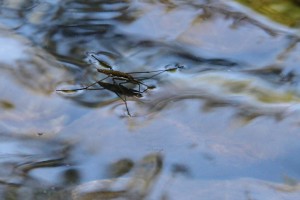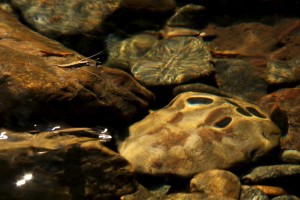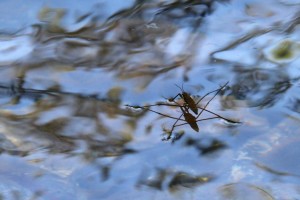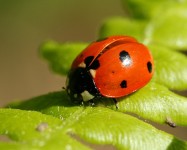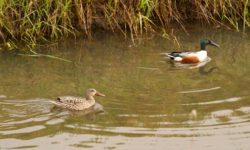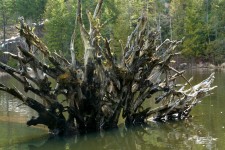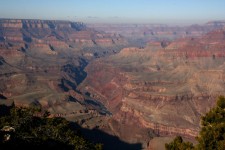While throwing rocks into Boulder Creek, I noticed the insects that look like big mosquitos walking on water in the eddies. I call them water striders but they are also called pond skaters, water spiders, water bugs, water skippers and Jesus bugs.
Water striders truly walk on water. Unlike boats and ducks that displace water, water striders stay on top of the water due to their legs and the water’s surface tension.
Microscopic hairs on their legs trap air bubbles that prevent their legs from becoming wet. These hairs (called microsetae) are invisible to the human eye because they are less than three micrometers in diameter (a human hair is 80 to 100 micrometers in diameter). Each hair is scored with grooves that are nanometers wide.
Since the hair is several layers thick, air becomes trapped between the hairs and grooves and forms an air cushion to prevent water from entering. Just as water rolls off a duck’s feather, water is repelled from a water strider’s leg but with greater efficiency. Scientists consider the water strider’s hairy legs to be superhydrophobic.
Water striders also walk on water because of the water’s surface tension. You may remember science class experiments of floating a needle on water or seeing how many drops of water fit on a penny before the surface tension broke.
Water acts differently at the surface because water molecules are attracted to each other and prefer to stay together. This attraction creates a membrane and thus surface tension.
Water striders create dimples on the water’s surface where their legs contact because they do weigh something. The dimples are only four millimeters deep and don’t break the surface tension.
The dimples create round shadows on the substrate beneath the water strider. Usually only four shadows are present because the water strider only uses four of its six legs to skate.
The water strider’s back legs are used to steer. The middle legs push the water strider forward much like a rowboat by moving backward in a sculling motion like oars. The backward motion produces swirls that propel the water strider forward.
Water striders can propel themselves forward at remarkable speeds–a hundred body lengths per second (their body length is half-an-inch). The equivalent for a six-foot tall person would be 400 miles per hour!
Even young water striders skate on the water like adults. They look like miniature adults after hatching. They only take one month to reach adult size through incomplete metamorphosis.
A water strider’s legs detect ripples in the water made by other insects and they quickly propel themselves to the source for a meal. Water striders prey on insects that accidentally fall in the water like butterflies, beetles and dragonflies. They also prey on water fleas, mayflies, stoneflies, honey bees, ants, crickets, worms and crane flies. Water striders also help control the mosquito population by preying on mosquito larvae that comes to the surface.
Water striders don’t actually eat the entire insect or worm. Since they are a true bug like aphids, cicadas and squash bugs, they have sucking mouthparts to suck the body juices from the prey.
Like praying mantis they use their front legs to capture prey. Water striders are so buoyant they can support 15 times their own weight without sinking. If they sink they are liable to drown unless they can make it to shore to dry out–a chance they take for spending their entire lives walking on water.

